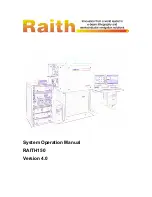
Büchi Labortechnik AG
Product description | 3
Operation Manual Lyovapor™ L-300/L-300 Pro
15/118
If a drying chamber with heating is used, heat transfer takes place additionally by
direct contact. The temperature of the heatable shelves is controllable. Control of
the thermal energy transferred is then possible.
Controlling the heat transfer prevents the following critical temperatures for
amorphous and crystalline materials in the solidified sample being reached:
the glass transition temperature T
g
' of the frozen sample.
the collapse temperature T
c
.
the eutectic temperature T
eu
.
Above the glass transition temperature and the collapse temperature, the viscosity
of the frozen sample decreases. The reduced viscosity leads to the collapse of the
sample's matrix structure.
Above the eutectic temperature, the sample melts.
During the main drying phase, the product temperature must remain below the
collapse temperature for amorphous materials in the sample.
Sublimation of the ice crystals progresses downwards from the surface of the
product. Above the sublimation boundary, the product is dry ("freeze-dried cake"),
while further inside the product is still frozen.
The end of the main drying phase is reached when all ice crystals have been
removed from the sample.
After the main drying phase, the remaining fluid content in the sample can still be
between 5 to 10%.
3.1.3
Secondary-drying phase
In the secondary drying phase, the unfrozen water is removed from the sample by
desorption. The secondary drying function is performed by the heatable shelves in
the drying chamber of the Lyovapor™.
In the secondary drying phase, the temperature of the heatable shelves is raised and
held for several hours.
The end of the secondary drying phase is reached when the residual moisture in the
sample is between 1% and 5% or the end point determination is succeeded.
3.2
Configuration
3.2.1
Front View
NOTE
For technical specifications of connections, see Chapter 3.6 "Technical data",
page 21
















































